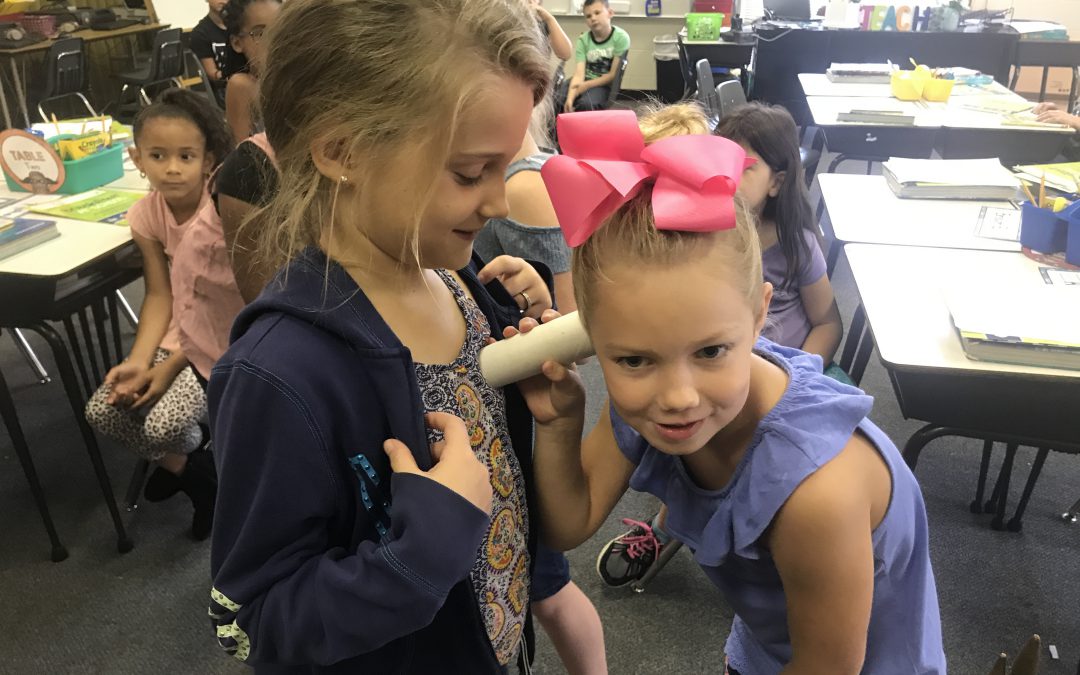
by Whitney Cherry | Oct 8, 2019
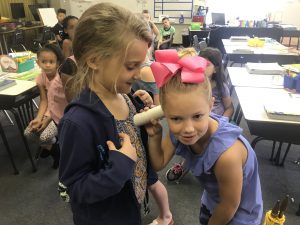
These young 4-H’ers are learning all that 4-H has to offer right in their schools through 4-H school clubs and school enrichment programs.
Heart is the second of the four H’s in the 4-H Pledge: head, HEART, hands and health. You can measure things of head, hands, and health, fairly simply. But to take the measure of a person’s heart is a little more tricky, and it is in my estimation, their truest measure. Your heart determines how you think, act, and respond to others. It’s the influence of your character.
In 4-H, we strive to give young people the opportunity to build character through a number of activities. Through service learning, we teach 4-Hers to consider others before themselves. Through democratic decision making, we teach them to be fair, even when it doesn’t mean equal. Through club membership, they learn loyalty. Through projects and fair entries, they learn patience with themselves and others. Through competition, how to be humble winners and gracious losers. And through awards and recognition, they learn the satisfaction of reaching a goal through hard work. We write thank you letters to learn gratitude. And above all, through teamwork, we teach that respect means being kind to others even when we don’t agree, and that all people deserve respect.
At a time when current events may leave us feeling discouraged, I encourage you to consider this instead. Just as a farmer’s fields of green inspire hope for a fruitful harvest, whenever I look out on my own fields of green – young people in 4-H shirts of course – ready to go to work for themselves or others, I too feel hope for a bright and promising future. These young people aren’t just learning to show hogs, shoot targets, sew, bake, or build a robot. They are learning to care about something larger than themselves. And that is, in fact, the promise of youth – which is exactly the stuff 4-H is made of.
For more information on how your family can learn more about 4-H, its enriching opportunities and the positive impacts made on young people, find your local UF IFAS Extension Office and contact your 4-H Agent to explore what 4-H programs are offered in your area.
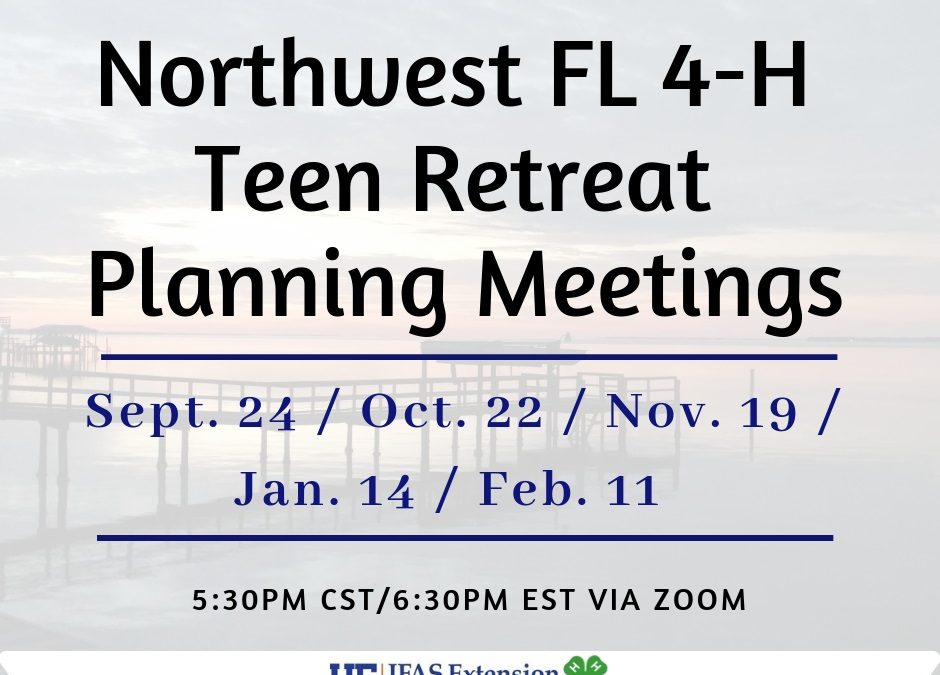
by Whitney Cherry | Sep 6, 2019
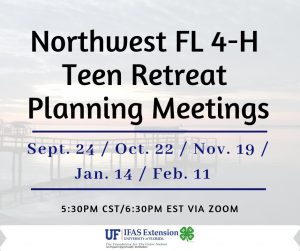 The start of the new 4-H year means it’s time to start gearing up for the 2020 NW District Teen Retreat! All teens ages 13-18 as of September 1, 2019 are invited to be on the Planning Committee. Teen Retreat is a high-energy weekend of learning, skill building, and networking with teens from across the 16 counties that make up the Northwest 4-H District of Florida. Planning Committee members set the agenda, choose the theme, activities, and workshop topics, and serve in leadership and teaching roles of their choice during the retreat.
The start of the new 4-H year means it’s time to start gearing up for the 2020 NW District Teen Retreat! All teens ages 13-18 as of September 1, 2019 are invited to be on the Planning Committee. Teen Retreat is a high-energy weekend of learning, skill building, and networking with teens from across the 16 counties that make up the Northwest 4-H District of Florida. Planning Committee members set the agenda, choose the theme, activities, and workshop topics, and serve in leadership and teaching roles of their choice during the retreat.
Committee meetings are held via video conference and can be joined online or by phone at home, on the road, or from your local Extension/4-H Office. To sign up for this committee, please contact your County 4-H Agent for the call-in information. Our goal is to make Teen Retreat 2020 the best one yet, and we can’t do it without you!
DATES TO KNOW:
- Teen Retreat 2020: February 21-23, 2020 at 4-H Camp Timpoochee, Niceville, FL
- Planning Committee Meetings: (for agents and teens)
- Tuesday, September 24, 2020 via Zoom @ 5:30 CT/6:30 ET
- Tuesday, October 22, 2020 via Zoom @ 5:30 PM CT/6:30 ET
- Tuesday, November 19, 2020 via Zoom @ 5:30 PM CT/6:30 ET
- Tuesday, January 14, 2020 via Zoom @ 5:30 PM CT/6:30 ET
- Tuesday, February 11, 2020 via Zoom @ 5:30 PM CT/6:30 ET
RESOURCES:
Get the Zoom app here
Questions? Contact your 4-H Agent & get involved with 4-H!
by Whitney Cherry | Apr 18, 2019
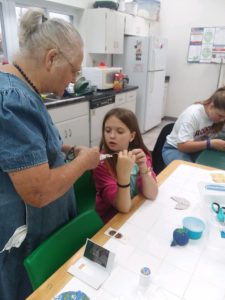
Volunteers across the panhandle make a difference in the lives of young people in their communities by simply sharing the things they love.
June Clemons and Peg Frith are a mother-daughter team who can do anything! From time to time, they’ve volunteered for 4-H, but the first time I asked them to help me teach a small sewing project during a cooking day camp, I knew I’d struck gold. Anyone can learn to sew but having the patience to teach it…that’s a whole other story.
It took me a couple of years to talk them into leading a sewing club, and honestly, I think they talked themselves into it. The holdup wasn’t a lack of desire to help; it was hesitancy to commit to something but not being able to follow through.
In fact, Peg’s advice to anyone thinking about becoming a 4-H volunteer is:
“I’d tell them it can be hard to find the time to plan, organize, and implement meetings, but it’s very rewarding. If you commit, see it through. Don’t disappoint the children.”
June emphatically said, “Do it!”
So why do June and Peg commit their precious time to 4-H? They first got involved because they had positive experiences as 4-H’ers and wanted to pass on the skills they learned. But now, it’s the kids they work with that keep them coming back. They both said that “teaching useful, lifelong skills to children and just enjoying being with them as they learn,” is their favorite part about volunteering with 4-H.
I asked June and Peg if they thought their 4-H work was making a difference.
June says, “All you have to do is see the joy in their faces upon completing a task to know how it affects the members.”
Peg added, “I get to see firsthand their sense of accomplishment. And the fact that they keep coming back to class tells me that the club is making a difference in their lives.”
As further evidence that June and Peg are making a difference, club parents have shared their children not only come home from their sewing club meetings excited to show what they made that day, but they have also started stitching up seams in their clothes and stuffed animals.
As a 4-H agent, I can tell you that the independence and mastery displayed by these young club members is exactly what we’re looking for from our 4-H’ers, and good club leaders help them achieve it.
Are you wondering if you have what it takes to make a difference in the lives of young people in your community?
You don’t have to be an expert. You don’t have to have kids or grandkids of your own. You don’t have to have been a former 4-H’er. You just have to love something enough to want to share it with the next generation. So what’s your passion? Pass it on!
There are many ways to volunteer with 4-H, and we need you – from fair exhibit and public speaking judges, to club leaders, chaperones, camp nurses, and more. To pass on your passion and help the youth in your area Grow in 4-H, contact your local UF/IFAS Extension Office to find the best volunteer role for you.
by Whitney Cherry | Mar 8, 2019
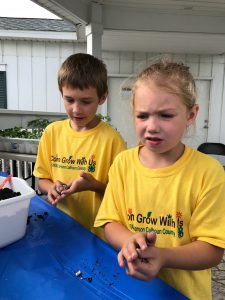
Wildflower seed bombs are a great indoor or outdoor project with unlimited potential for learning.
Wildflower seed bombs are the perfect project for kids itching to get outside. Even if you don’t have a green thumb or you don’t have outdoor space or the weather isn’t cooperating, you can make seed bombs that will help beautify roadsides, vacant areas and neighborhoods.
Give Them a Toss!
These little beauties don’t get their name from any explosive properties but from the fun you have “launching” them around your yard or neighborhood. As you toss them into places that aren’t frequently mowed, you beautify your neighborhood and provide an invaluable food sources for native Florida pollinators like bees, wasps, butterflies, and more.
Even though you may be more fond of some pollinators than others, there’s no doubt we need them all. Their pollination services are critical to fruit development in many of our fruiting crops. So if you like squash, cucumbers, melons, almonds and so much more, here’s what you can do to help:
Gather Your Materials
- Air-dry clay
- Wildflower seeds
- Potting Soil
Make Your Seed Bombs
- Pinch off a small amount of air-dry clay – enough to make a ball about the size of a bouncy ball or about 1″ diameter.
- Work equal parts seeds and soil into the clay and form it into a ball.
Amounts really are up to you. More seeds = more flowers.
But, too much soil will keep the ball from holding it’s shape. If this happens, add more clay and either have a bigger bomb, or divide it into two smaller bombs.
- Store them in a cool dry place and let them dry out completely in an air-tight container until you’re ready to spread some wildflower cheer.
- Now for the fun part! Toss them where you want flowers to grow.
Things to Consider…
- The air-dry clay acts as a binder only. It’s natural, non-toxic, and when wet, it will soften and allow the seeds to grow.
- Before storing in an airtight container, allow your seed bombs out to dry completely. Even a little moisture will allow the seeds to sprout.
- Be careful when throwing your seed bombs.
- Don’t hit people, animals, or other anything else with them – just the ground.
- Throw them where areas don’t get mowed very much. Some people throw them out along roadways or in abandoned lots. If these places are mowed regularly, they won’t last long if they even get to bloom.
- Get permission if you’re throwing them in public places.
Resources
Gardening is just one of the many Florida 4-H programs. To see what programs are available in your county, contact your local UF/IFAS Extension office, or contact your 4-H Agent about starting a gardening program in your county.
by Whitney Cherry | Jan 4, 2019
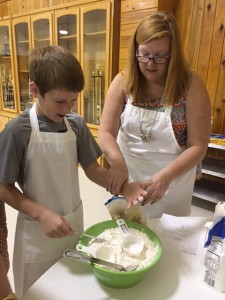
Cooking together makes memories that last longer than gifts. Photo: Monica Brinkley
This is one New Year’s resolution that I can get behind –
give less stuff and give more self. We’ve just wrapped up December – a month of massive giving. We gave gifts, we made charitable monetary donations, and we’ve overdone “bake-and-take” as I call it. It takes a lot of expendable income to give so many things, but you can choose to manage your resources wisely throughout the year and give through acts of service instead.
I particularly love this idea with small children who may want to buy gifts for loved ones but who aren’t old enough to earn money yet, but it works great for kids of all ages. Rather than doing coupon books for hugs and kisses (cute and welcome as those may be), I help them arrange to spend part of a day with a loved one instead. They help with household chores, do some baking or cooking with them, tackle a difficult chore and so on. Not only are they helping with age appropriate tasks, but they’re getting to spend time together and make memories.
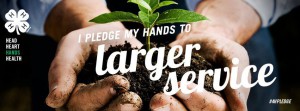
Encourage youth in your life to look around during the year and see who needs help and what they can do to help. Instead of giving more stuff, give more self.
4-H teaches youth life skills such as planning/organizing, wise use of resources, social skills, and character. By encouraging 4-H youth to serve in any large or small way they can, we help them build these and other crucial life skills. Find your local UF/IFAS Extension office to explore how 4-H teaches youth valuable life skills through its project areas..








